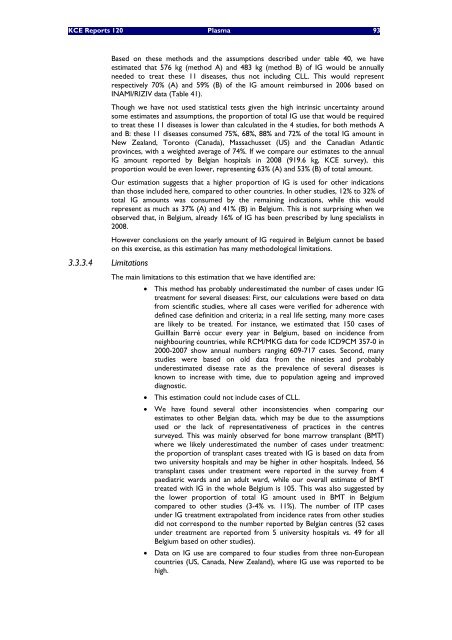The report is available in English with a French summary - KCE
The report is available in English with a French summary - KCE
The report is available in English with a French summary - KCE
You also want an ePaper? Increase the reach of your titles
YUMPU automatically turns print PDFs into web optimized ePapers that Google loves.
<strong>KCE</strong> Reports 120 Plasma 93<br />
Based on these methods and the assumptions described under table 40, we have<br />
estimated that 576 kg (method A) and 483 kg (method B) of IG would be annually<br />
needed to treat these 11 d<strong>is</strong>eases, thus not <strong>in</strong>clud<strong>in</strong>g CLL. Th<strong>is</strong> would represent<br />
respectively 70% (A) and 59% (B) of the IG amount reimbursed <strong>in</strong> 2006 based on<br />
INAMI/RIZIV data (Table 41).<br />
Though we have not used stat<strong>is</strong>tical tests given the high <strong>in</strong>tr<strong>in</strong>sic uncerta<strong>in</strong>ty around<br />
some estimates and assumptions, the proportion of total IG use that would be required<br />
to treat these 11 d<strong>is</strong>eases <strong>is</strong> lower than calculated <strong>in</strong> the 4 studies, for both methods A<br />
and B: these 11 d<strong>is</strong>eases consumed 75%, 68%, 88% and 72% of the total IG amount <strong>in</strong><br />
New Zealand, Toronto (Canada), Massachusset (US) and the Canadian Atlantic<br />
prov<strong>in</strong>ces, <strong>with</strong> a weighted average of 74%. If we compare our estimates to the annual<br />
IG amount <strong>report</strong>ed by Belgian hospitals <strong>in</strong> 2008 (919.6 kg, <strong>KCE</strong> survey), th<strong>is</strong><br />
proportion would be even lower, represent<strong>in</strong>g 63% (A) and 53% (B) of total amount.<br />
Our estimation suggests that a higher proportion of IG <strong>is</strong> used for other <strong>in</strong>dications<br />
than those <strong>in</strong>cluded here, compared to other countries. In other studies, 12% to 32% of<br />
total IG amounts was consumed by the rema<strong>in</strong><strong>in</strong>g <strong>in</strong>dications, while th<strong>is</strong> would<br />
represent as much as 37% (A) and 41% (B) <strong>in</strong> Belgium. Th<strong>is</strong> <strong>is</strong> not surpr<strong>is</strong><strong>in</strong>g when we<br />
observed that, <strong>in</strong> Belgium, already 16% of IG has been prescribed by lung special<strong>is</strong>ts <strong>in</strong><br />
2008.<br />
However conclusions on the yearly amount of IG required <strong>in</strong> Belgium cannot be based<br />
on th<strong>is</strong> exerc<strong>is</strong>e, as th<strong>is</strong> estimation has many methodological limitations.<br />
3.3.3.4 Limitations<br />
<strong>The</strong> ma<strong>in</strong> limitations to th<strong>is</strong> estimation that we have identified are:<br />
• Th<strong>is</strong> method has probably underestimated the number of cases under IG<br />
treatment for several d<strong>is</strong>eases: First, our calculations were based on data<br />
from scientific studies, where all cases were verified for adherence <strong>with</strong><br />
def<strong>in</strong>ed case def<strong>in</strong>ition and criteria; <strong>in</strong> a real life sett<strong>in</strong>g, many more cases<br />
are likely to be treated. For <strong>in</strong>stance, we estimated that 150 cases of<br />
Guillla<strong>in</strong> Barré occur every year <strong>in</strong> Belgium, based on <strong>in</strong>cidence from<br />
neighbour<strong>in</strong>g countries, while RCM/MKG data for code ICD9CM 357-0 <strong>in</strong><br />
2000-2007 show annual numbers rang<strong>in</strong>g 609-717 cases. Second, many<br />
studies were based on old data from the n<strong>in</strong>eties and probably<br />
underestimated d<strong>is</strong>ease rate as the prevalence of several d<strong>is</strong>eases <strong>is</strong><br />
known to <strong>in</strong>crease <strong>with</strong> time, due to population age<strong>in</strong>g and improved<br />
diagnostic.<br />
• Th<strong>is</strong> estimation could not <strong>in</strong>clude cases of CLL.<br />
• We have found several other <strong>in</strong>cons<strong>is</strong>tencies when compar<strong>in</strong>g our<br />
estimates to other Belgian data, which may be due to the assumptions<br />
used or the lack of representativeness of practices <strong>in</strong> the centres<br />
surveyed. Th<strong>is</strong> was ma<strong>in</strong>ly observed for bone marrow transplant (BMT)<br />
where we likely underestimated the number of cases under treatment:<br />
the proportion of transplant cases treated <strong>with</strong> IG <strong>is</strong> based on data from<br />
two university hospitals and may be higher <strong>in</strong> other hospitals. Indeed, 56<br />
transplant cases under treatment were <strong>report</strong>ed <strong>in</strong> the survey from 4<br />
paediatric wards and an adult ward, while our overall estimate of BMT<br />
treated <strong>with</strong> IG <strong>in</strong> the whole Belgium <strong>is</strong> 105. Th<strong>is</strong> was also suggested by<br />
the lower proportion of total IG amount used <strong>in</strong> BMT <strong>in</strong> Belgium<br />
compared to other studies (3-4% vs. 11%). <strong>The</strong> number of ITP cases<br />
under IG treatment extrapolated from <strong>in</strong>cidence rates from other studies<br />
did not correspond to the number <strong>report</strong>ed by Belgian centres (52 cases<br />
under treatment are <strong>report</strong>ed from 5 university hospitals vs. 49 for all<br />
Belgium based on other studies).<br />
• Data on IG use are compared to four studies from three non-European<br />
countries (US, Canada, New Zealand), where IG use was <strong>report</strong>ed to be<br />
high.

















